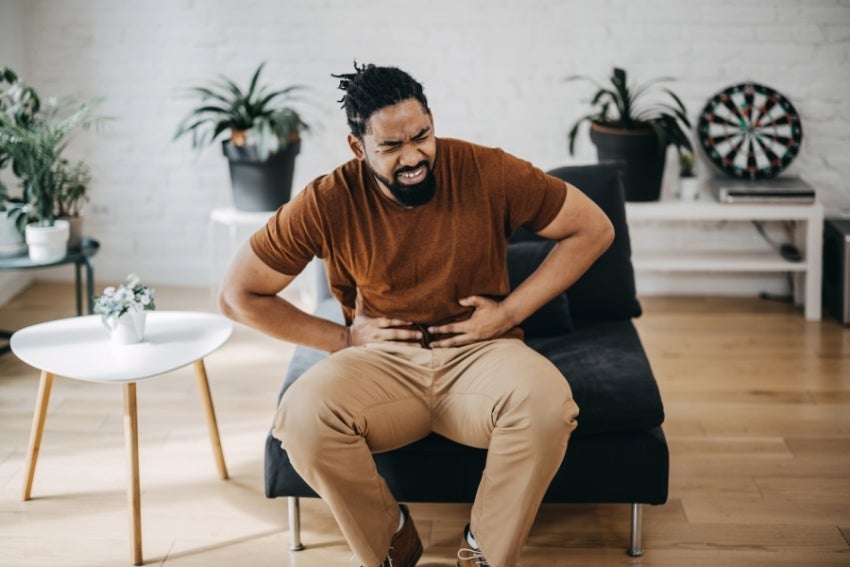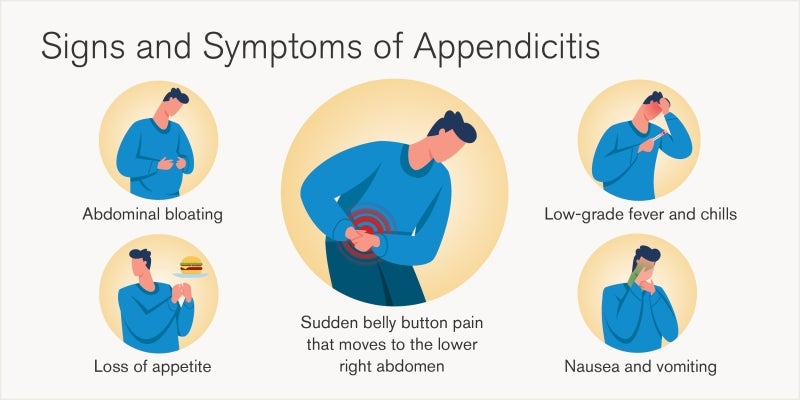Understanding Appendicitis: Symptoms, Causes, Treatment, & Recovery
June 23, 2025
Categories: General Surgery, Emergency Care
Tags: appendicitis, Abdominal Pain
By: Gifty Abraham, MD, General Surgery
Appendicitis is one of the most common reasons for emergency surgery in the United States. While it affects people of various ages, it most frequently occurs in younger individuals, from teens through their 30s. It's estimated that up to nine out of every 100 people will suffer from appendicitis at some point in their life. Knowing what signs to look for and understanding when to seek medical attention can significantly impact recovery.
“Appendicitis can come on quickly and catch people off guard,” said Gifty Abraham, MD, a general surgeon at Loyola Medicine. “Knowing the warning signs and acting early can make a big difference in how effectively it’s treated.”
What is appendicitis?
Appendicitis is an inflammation of the appendix, a small, tube-like organ attached to the large intestine. This inflammation can cause severe abdominal pain and is usually due to an infection or a stool blockage. Other potential causes include bacterial infections, parasites, and growths or tumors within the appendix. Risk factors include constipation and being younger, although appendicitis can occur in older adults as well.
“Most of the time, appendicitis happens because the opening to the appendix is obstructed or blocked, which leads to irritation and swelling,” explained Dr. Abraham. “In many cases, it’s a small stone-like mass of stool, but infections and other blockages can also trigger it.”
Recognizing symptoms of appendicitis and when to seek medical attention
Appendicitis symptoms often start subtly but become progressively worse over time, making it critical to recognize them early and seek prompt medical care.
Symptoms might resemble food poisoning or a stomach bug initially, but persistent pain that moves toward the lower right side of the abdomen and doesn't improve over a few hours, especially with fever, strongly suggests appendicitis. Women might find it more challenging to differentiate due to overlapping symptoms from reproductive organs. Regardless, pain lasting more than a few hours, particularly if accompanied by fever or vomiting, warrants immediate medical evaluation.
“If the pain starts near your belly button and then shifts to the lower right side, that’s a red flag,” said Dr. Abraham. “And if it sticks around for a few hours, especially with a fever or nausea, it’s time to go to the ER.”

Appendicitis in children and older adults
Appendicitis can present differently across various age groups. In children, especially very young ones, symptoms might be less specific, making diagnosis more challenging. Children may not clearly communicate their pain or may display generalized abdominal discomfort, lethargy, or irritability. Pediatricians typically rely on ultrasounds initially, reducing exposure to radiation from CT scans.
Older adults, on the other hand, might experience less pronounced pain and delayed fever response, leading to late diagnosis and increased risk of complications. Regular health evaluations and prompt attention to unusual abdominal pain in older individuals are crucial.
Understanding the symptoms across different age groups and acting swiftly can prevent complications and promote rapid recovery. If you or someone you know experiences persistent abdominal pain accompanied by fever or nausea, seek immediate medical evaluation to rule out appendicitis.
Diagnosing and treating appendicitis
When you visit the emergency room with suspected appendicitis, doctors will first conduct a thorough medical history and physical examination to assess your symptoms and overall condition. They will also perform blood tests to check for infection. Typically, a CT scan is used to confirm the diagnosis by revealing an enlarged, thickened appendix or fluid accumulation around the appendix. In children, an ultrasound might sometimes be used instead.
Treatment for appendicitis usually involves surgery to remove the appendix, known as an appendectomy. Most appendectomies are performed laparoscopically, meaning they involve small incisions, resulting in quicker recovery times and fewer complications compared to open surgery.
However, not all cases of appendicitis require immediate surgery. If caught early and symptoms are mild, treatment may include hospitalization for antibiotics and careful monitoring. This non-operative approach is gaining popularity, but regular follow-ups are crucial to ensure full recovery.
Complications resulting from an inflamed appendix
If appendicitis is not treated promptly, the appendix can rupture, leading to severe complications such as infection spreading throughout the abdomen (peritonitis) or an abscess. People experiencing perforation typically endure persistent symptoms for several days before seeking medical attention, highlighting the importance of early diagnosis and treatment.
In stable cases where rupture occurs, treatment may involve antibiotics and drainage procedures performed by radiologists. In more severe or unstable cases, immediate surgery is necessary to control the infection and remove the appendix.
“Some patients try to wait it out, thinking the pain will pass,” Dr. Abraham said. “But delaying care can lead to a ruptured appendix—and once that happens, treatment becomes much more complex.”
Recovery after appendectomy
Recovery following an appendectomy generally involves a short hospital stay, typically one to two days, especially after laparoscopic surgery. During recovery:
- Patients are encouraged to move around early to speed up the healing process.
- Pain management usually involves over-the-counter medications, although prescription pain medication may be provided initially.
- Most patients can return to normal activities within one to three weeks, depending on the surgery type and individual health conditions.
It's important to follow the post-operative care instructions closely. These often include recommendations on diet, such as starting with liquids and gradually returning to regular food, as well as guidelines for wound care and physical activities.
Patients should monitor for signs of complications, including increased redness, swelling, discharge from surgical sites, persistent pain, or fever, and seek medical attention immediately if these occur.
Prevention and long-term health after appendix removal
Currently, there are no proven ways to prevent appendicitis entirely, as its exact causes remain varied and somewhat unclear. Maintaining a diet rich in fiber and staying hydrated may help reduce the risk of constipation and blockages, potentially lowering the risk.
Long-term health after an appendectomy is typically unaffected, as the appendix does not have any critical known function. Ongoing research continues to investigate potential roles of the appendix in immune or gut health, but removing it is not associated with significant long-term health issues.
“The appendix is a vestigial organ, meaning we don’t believe it serves a necessary function,” said Dr. Abraham. “Patients usually recover completely, with no long-term health issues after an appendectomy.”
General surgery at Loyola Medicine
Loyola Medicine’s general surgery team is known for its advanced expertise, innovative techniques and patient-centered care. Our board-certified surgeons use the latest minimally invasive and laparoscopic techniques to treat a wide range of conditions—from common procedures like appendectomies to complex abdominal and oncologic surgeries.
Patients benefit from our academic medical center environment, where surgeons collaborate closely with specialists in radiology, gastroenterology, infectious disease and critical care to deliver comprehensive and coordinated treatment plans. We also provide state-of-the-art imaging and diagnostics that support faster, more accurate evaluations.
Dr. Gifty Abraham is a board-certified general surgeon at Loyola Medicine and serves as Associate Program Director for the General Surgery Residency. She specializes in minimally-invasive procedures, including appendectomies, and is committed to compassionate, patient-focused care.
